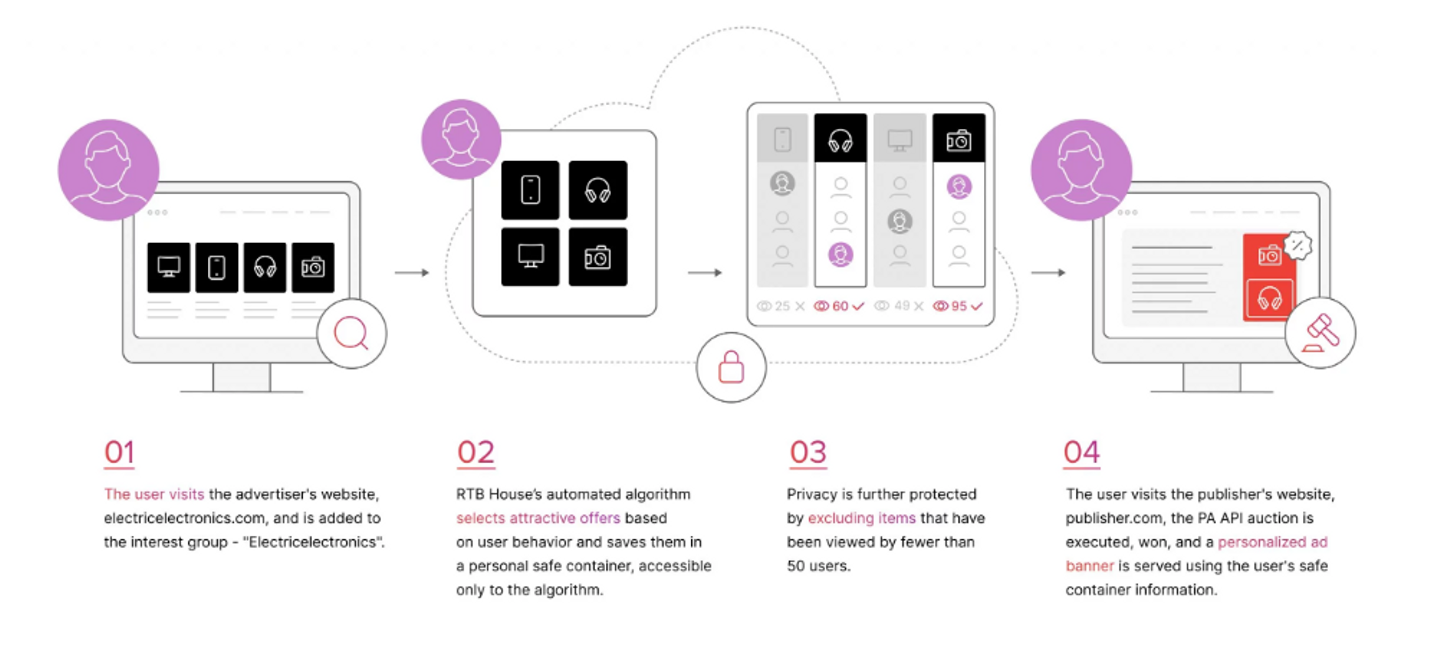Personalized Product Recommendations Without Cookies—Product-Level Turtledove
In early 2020, Google first announced its intention to retire third-party cookies from Chrome. Despite numerous twists and turns, one thing remains certain: the relevance of third-party cookies is on a downward trend across most browsers, and this will likely affect Chrome as well. This development has marketers worried about the future of personalized and relevant advertising. The good news is they don’t need to be concerned. RTB House has managed to fine-tune Chrome’s new cookieless tool—the Privacy Sandbox—so that it can tailor ads to specific users while protecting their privacy. How is this possible, and what role does the Product-Level Turtledove play in the process? Let’s dive into it.
Table of Contents:
- RTB House’s contribution to the Privacy Sandbox
- Privacy can go hand-in-hand with utility
- How PLTD Delivers Value to the Average Internet User: A Step-by-Step Example
- Conclusion
RTB House’s contribution to the Privacy Sandbox
There are various substitutes out there for third-party cookies, but one stands out because of its native support in Google’s browser: the Privacy Sandbox. This initiative comprises over 20 APIs designed to compensate publishers and advertisers for the future absence of third-party cookies. The most sophisticated and powerful of these APIs is the Protected Audience API (previously known as FLEDGE). RTB House recognized the Protected Audience API’s privacy-centric architecture and saw it as a promising tool for retargeting in the “post-cookie” world.
However, despite its potential, the API lacked an essential component for effective and privacy-friendly ad impression personalization. RTB House designed the missing piece—the Product-Level Turtledove. Since this mechanism maintained the highest standards of user privacy, Chrome fully integrated it into the Protected Audience API (originally called Turtledove in the early days of the Privacy Sandbox).
In this article, we will highlight the value that this extension brings and explain why we, as its primary authors, believe that core e-commerce use cases are well-supported within the Privacy Sandbox.
Privacy can go hand-in-hand with utility
The main objective of the Privacy Sandbox was to provide the ad tech industry with a privacy-friendly and effective alternative to third-party cookies. The Privacy Sandbox aims to reinvent the way user data is handled across the web, discouraging the activities of bad actors while still allowing legitimate use cases, such as the types of personalized digital marketing that were previously facilitated by third-party cookies.
The Protected Audience API builds on a mechanism called an interest group. These interest groups are typically created and managed by an advertiser’s trusted tech vendor based on the advertiser’s first-party data. When a user browses the advertiser’s website, they are added to an interest group. Information about that interest group is later passed into the bid stream, instead of the personal identifiers that are used in the classic cookie-based system. This means that when the user is included in the bid stream they are indistinguishable from other members who are in the same interest group. Anonymity is ensured by two things:
- The fact that an interest group is only biddable when it reaches a minimum threshold of users (a concept known as k-anonymity),
- The fact that personal user data, including personal identifiers, is hidden from external actors within deeper, secure layers of the ecosystem, either on-device or in secure cloud storage. This data is processed in an automated manner without any party having oversight.
The Product-Level Turtledove enhances this system by automatically and intelligently selecting the offers most likely to meet the campaign’s objectives based on the user’s behavior on the advertiser’s site. These can be later displayed as banners if the interest group owner wins the auction. Banners are a key element of the performance marketing puzzle, as they consist of multiple product slots. This characteristic has proven to be very efficient at driving conversions. However, before each offer can appear on a banner, it must first meet the k-anonymity criterion.
Let’s take a look at an illustration of this concept to make it easier to understand.

How PLTD Delivers Value to the Average Internet User: A Step-by-Step Example
If the high-level description and graph were not enough to properly deliver on the promises made in the article title, we can analyze a real-life, step-by-step example of how this system can deliver value for an average internet user.
Context: Let’s consider Mark, who is looking to buy some red headphones. Mark visited the ElectricElectronics.com website to find the right product for himself. While on the website, he viewed five different models of red headphones. Two of them in particular caught his attention, and he added them to his cart. While he was browsing, he also looked at a few other products: one black and two red 55-inch TV sets, and one silver smartphone. After that, he left the site without completing his order. Our task: Imagine we are in a cookieless world and want to encourage Mark to return to ElectricElectronics.com and finish his order. We could achieve this by displaying an attractive banner with offers relevant to him.
How it’s done with the PLTD: To maximize the probability of conversion, we need to create a suitable and attractive banner for Mark. The Product-Level Turtledove allows us to choose the offers most likely to draw Mark’s attention and display them on the banner. In our scenario, the algorithm could determine that since Mark visited the pages of multiple headphones and TV sets, these are the products he is most interested in. The algorithm rejected the smartphone category, since it was only visited once, but accounted for the red color, a common denominator for Mark’s most browsed products. Thanks to PLTD, the red headphones and red TV sets could be highlighted as the most desired items to put on the banner.
When Mark visits the ProperPublisher.com website and RTB House wins the auction, the algorithm will select the offers to be placed on the banner. Let’s imagine that this is a 6-slot banner. In the first two slots, the algorithm will place the two headphone models that Mark put in his basket. For the next three slots, it would select the remaining three headphones. However, one of the pairs is a new release by Electric Electronics, which means the product page hasn’t been viewed by 50 users yet. Because of k-anonymity, this product can’t be selected for the banner. In this case, the other two headphone models will be selected for slots 3 and 4, while slots 5 and 6 will be filled by offers for the red TV sets Mark interacted with.
Effect: Seeing a banner with offers relevant to him, Mark is more likely to click on one of them, return to the store, and finalize the purchase.
How Mark’s privacy is protected: All information about Mark’s behavior on ElectricElectronics.com is siloed and only accessible in a privacy-preserving way to the advertiser or its trusted technological partner. It is never provided to any third parties. Mark can’t be recognized as Mark by Electric Electronics (nor by their trusted technological partner) after he leaves their website and enters ProperPublisher.com. His specific information is only accessible to an automated algorithm that runs in an isolated secure environment.
In this scenario, there was a niche/new product whose appearance on the banner would have made that particular combination of impressions unique, allowing Electric Electronics to re-identify Mark on the ProperPublisher.com website. The k-anonymity mechanism prevented that from happening.
As a result, Mark is exposed to offers that are relevant and interesting to him while his identity is protected.
Conclusion
The bottom line is that we can deliver personalized and relevant product recommendations without relying on cookies. Even in the absence of third-party cookies, RTB House has successfully preserved the capabilities of its sophisticated deep learning recommendation engine. If there is one key takeaway here, it is that a thorough understanding of these tools is essential for efficiently and privately personalizing impressions while using the Privacy Sandbox’s Protected Audience API. Since RTB House was the one to develop this mechanism, there is no better technological partner to turn to for future-proof, cookieless performance advertising at scale.


/assets/images/11840399/original/37f1aaf9-02e1-4237-9b94-1a402a256318?1674025461)
/assets/images/11840399/original/37f1aaf9-02e1-4237-9b94-1a402a256318?1674025461)

